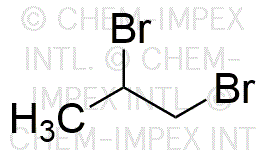1,2-Dibromopropane is widely utilized in research focused on:
- Organic Synthesis: This compound serves as a versatile intermediate in the synthesis of various organic molecules, making it valuable for chemists developing new pharmaceuticals and agrochemicals.
- Solvent Applications: It is used as a solvent in chemical reactions and extractions, particularly in laboratories where non-polar solvents are required for specific reactions.
- Chiral Synthesis: 1,2-Dibromopropane can be employed in the preparation of chiral compounds, which are essential in the production of many drugs, enhancing the efficacy and safety of medications.
- Polymer Production: The compound is utilized in the synthesis of certain polymers, contributing to the development of materials with unique properties for use in packaging and coatings.
- Research in Environmental Chemistry: It is also studied for its environmental impact and behavior, aiding researchers in understanding the degradation processes of brominated compounds in ecosystems.
General Information
Properties
Safety and Regulations
Applications
1,2-Dibromopropane is widely utilized in research focused on:
- Organic Synthesis: This compound serves as a versatile intermediate in the synthesis of various organic molecules, making it valuable for chemists developing new pharmaceuticals and agrochemicals.
- Solvent Applications: It is used as a solvent in chemical reactions and extractions, particularly in laboratories where non-polar solvents are required for specific reactions.
- Chiral Synthesis: 1,2-Dibromopropane can be employed in the preparation of chiral compounds, which are essential in the production of many drugs, enhancing the efficacy and safety of medications.
- Polymer Production: The compound is utilized in the synthesis of certain polymers, contributing to the development of materials with unique properties for use in packaging and coatings.
- Research in Environmental Chemistry: It is also studied for its environmental impact and behavior, aiding researchers in understanding the degradation processes of brominated compounds in ecosystems.
Documents
Safety Data Sheets (SDS)
The SDS provides comprehensive safety information on handling, storage, and disposal of the product.
Product Specification (PS)
The PS provides a comprehensive breakdown of the product’s properties, including chemical composition, physical state, purity, and storage requirements. It also details acceptable quality ranges and the product's intended applications.
Certificates of Analysis (COA)
Search for Certificates of Analysis (COA) by entering the products Lot Number. Lot and Batch Numbers can be found on a product’s label following the words ‘Lot’ or ‘Batch’.
*Catalog Number
*Lot Number
Certificates Of Origin (COO)
This COO confirms the country where the product was manufactured, and also details the materials and components used in it and whether it is derived from natural, synthetic, or other specific sources. This certificate may be required for customs, trade, and regulatory compliance.
*Catalog Number
*Lot Number
Safety Data Sheets (SDS)
The SDS provides comprehensive safety information on handling, storage, and disposal of the product.
DownloadProduct Specification (PS)
The PS provides a comprehensive breakdown of the product’s properties, including chemical composition, physical state, purity, and storage requirements. It also details acceptable quality ranges and the product's intended applications.
DownloadCertificates of Analysis (COA)
Search for Certificates of Analysis (COA) by entering the products Lot Number. Lot and Batch Numbers can be found on a product’s label following the words ‘Lot’ or ‘Batch’.
*Catalog Number
*Lot Number
Certificates Of Origin (COO)
This COO confirms the country where the product was manufactured, and also details the materials and components used in it and whether it is derived from natural, synthetic, or other specific sources. This certificate may be required for customs, trade, and regulatory compliance.


